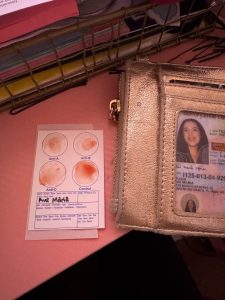13 Immunological Diagnostics- Blood Typing activity
Procedure:
Virtual Immunology Lab: ELISA
- Go to the “Virtual Lab Simulations” tab for this module and navigate to BioInteractive- Virtual Immunology Lab.
- Complete the virtual activity and answer all the questions in the simulation’s built-in notebook.
- Submit your notebook, pictures, and answer all questions under Results.
- Contact your TA or Dr. Oli if you run into any technology issues.
Complete the blood typing game or the virtual immunology lab to learn more about how ELISA can be used to test blood samples for diseases. Upload pictures and your completed lab notebook for this activity.
Blood-Typing Kit
- Using a sharpie clearly write your name on the Eldon card provided.
- Using a transfer pipette place a small drop of water in each colored circle. DO NOT TOUCH these colored reagents.
- Wash your hands with warm water and make sure that they are thoroughly dried.
- Take the lancet and twist the colored tip. Be careful not to activate the lancet; it can only be used once.
- Pull off the tip of the safety lancet.
- Disinfect the place where you will do the prick with using the provided alcohol wipe and allow it to air dry.
- Rub your hands together for 5 minutes. (This will assist with blood flow and soften the skin to make penetrating the skin easier in the following step.)
- After the 5 minute mark, place hand flat on table with palm facing upwards and prick either your middle or ring finger.
- Place the lancing with the opening facing your finger and push down until you hear a “click”
- Remove the lancet from your finger
- Keep arm down on a table and gently press the blood towards the finger.
- Continue pressing until a drop of blood with a 3-4mm diameter is seen.
- Apply the blood to an Eldon stick (you were given 4 in your blood typing kit)
- Approach from underneath the finger so that you do not smear over the skin
- Place the stick with blood onto the first circular field. Allow it to touch the water already present.
- Repeat steps 8-9 three times using the remaining Eldon sticks. Make sure to keep each stick inside its own field separate from the other sticks.
- Stir the blood into the first field with the Eldon stick for 10 seconds to dissolve the reagents. Try to cover the entire field of the circle but do not cover beyond each circle.
- Repeat step 10 in the remaining fields using their own sticks. In order to prevent the blood from clotting begin stirring within 2 minutes of applying blood to the first Eldon stick after initially pricking the finger.
- The contact between the red blood cells and reagents may cause the cells to agglutinate into a grainy structure. Tilt the card for at least 40 seconds to develop all possible agglutinates. Tilt the card upright for 10 seconds, to the right vertical position for 10 seconds, and twice for the other edges for 10 seconds each.
- Determine your blood type and Rhesus factor
- Optional: Leave the card to dry on a flat surface. When the blood is completely dry use a piece of ELDONFOIL 2511 to encapsulate the blood and preserve the result.
Results:
Virtual Simulation: Blood Type Game

Blood Test Lab:
The Enzyme-Linked Immunosorbent Assay (ELISA) is a widely used diagnostic technique to detect and quantify substances such as proteins, antibodies, or hormones in a sample. It is important because it offers high sensitivity and specificity, making it ideal for diagnosing diseases, monitoring immune responses, and conducting research. Common applications include detecting pathogens, autoimmune diseases, and certain cancers. The washing steps in an ELISA are crucial for removing unbound substances, such as non-specific proteins or antibodies, from the wells. This ensures that only the target molecules remain bound, reducing background noise and improving the accuracy of the results. False positives occur when the test incorrectly indicates the presence of the target substance. Causes include cross-reactivity with non-target substances or improper washing, leaving unbound antibodies or antigens behind. False negatives happen when the test fails to detect the target substance. Causes include insufficient sample quantity, degraded target molecules, or issues with reagent sensitivity.
Blood typing determines an individual’s blood group based on the presence or absence of specific antigens (A, B) on the surface of red blood cells. The test involves mixing a blood sample with anti-A and anti-B antibodies. Agglutination (clumping) indicates the presence of the corresponding antigen. For example, clumping with anti-A antibodies but not anti-B indicates blood type A. The Rh factor is determined similarly, identifying if the blood type is positive (Rh+) or negative (Rh-).
Immunological diagnostics are vital for detecting diseases and monitoring immune responses. These tests identify specific antibodies or antigens in a sample, allowing for the diagnosis of conditions such as infections, allergies, and autoimmune diseases. ELISA: Detects antibodies or antigens, used for diseases like HIV or Lyme disease. Western Blot: Confirms the presence of specific proteins, often following an ELISA test. Rapid Influenza Diagnostic Tests (RIDTs): Identify influenza antigens within minutes.
Rapid COVID-19 Tests are often antigen-based, these detect viral proteins from a nasal or throat swab. They provide quick results, typically within 15–30 minutes, and are convenient for screening. Rapid tests are less sensitive and more prone to false negatives compared to PCR tests, which detect viral RNA in a lab setting. PCR tests are highly sensitive and specific but require more time and specialized equipment. Advantages of Rapid Tests include speed, accessibility, and ease of use. Advantages of Lab Tests (e.g., PCR) include higher sensitivity and reliability, especially in early or asymptomatic cases.
Photo of ELDON Blood Typing:

According to the results of the blood typing, I am O-positive. This is because there is only clotting in the Anti-D circle.
